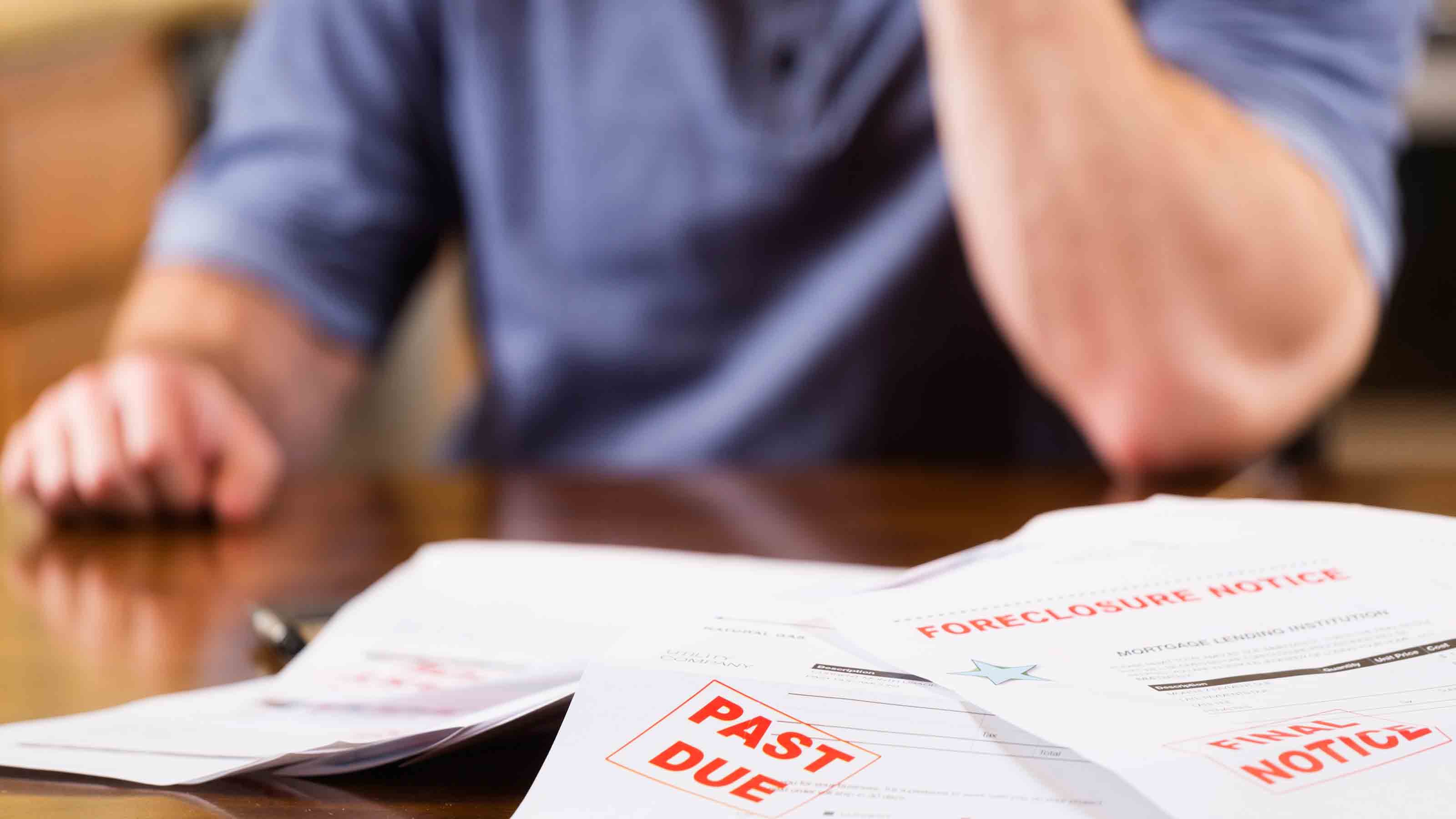When Is Bankruptcy the Right Move?
Seeking protection from creditors can provide a lifeline, but there are plenty of trade-offs.


The COVID-19 pandemic in the U.S. officially turns one year old in March. But despite statewide lockdowns, business closures and widespread layoffs triggered by COVID, personal bankruptcy filings have not increased. Data through November from the American Bankruptcy Institute shows that filings were down 35% from 2019.
Robert Lawless, a professor at the University of Illinois who specializes in bankruptcy law, credits the economic stimulus enacted in early 2020, which included a moratorium on debt collections, for the decline in bankruptcy filings. Families are spending less and saving more, which is also slowing filings, he says. But this trend could change in the months ahead. In his research, Lawless has found that people tend to struggle financially for two to three years before deciding to file for bankruptcy. If you’re worried about not being able to dig yourself out from under your debts, here’s what you need to know.
Two options. Personal or consumer bankruptcy is separated into two sections, or chapters: Chapter 7 and Chapter 13 (business bankruptcies are known as Chapter 11). Chapter 7 bankruptcy, also known as a liquidation, is simpler to file and takes less time to complete. Most people opt for Chapter 7 because it allows you to wipe out most of your debts. It may require you to sell some of your assets, such as any non-retirement investments you own, to pay your creditors, although you may be able to keep your home. Chapter 13 is designed for people who have enough stable income to pay back some of their debts through a repayment plan. In a Chapter 13 bankruptcy, you can keep all of your property, including your house.
From just $107.88 $24.99 for Kiplinger Personal Finance
Become a smarter, better informed investor. Subscribe from just $107.88 $24.99, plus get up to 4 Special Issues

Sign up for Kiplinger’s Free Newsletters
Profit and prosper with the best of expert advice on investing, taxes, retirement, personal finance and more - straight to your e-mail.
Profit and prosper with the best of expert advice - straight to your e-mail.
Although Chapter 7 provides the opportunity for a fresh start, it also takes a bigger toll on your assets. Plus, not everyone is eligible for Chapter 7. A lawyer will determine whether you qualify based on your state’s household income requirements, which vary considerably. For example, in California, a family of four with an annual gross (before tax) income of less than $101,315 qualifies for Chapter 7. In Arizona, a family of four must make less than $86,950.
Your attorney will also analyze other aspects of your financial life to determine whether Chapter 7 is the best route for you. Chapter 7 may not be best if you’re a homeowner who has a large amount of home equity (but cannot access it with a home-equity loan because of credit problems) because you could lose your home and the equity you’ve earned, says Gregory Wade, a bankruptcy attorney in Alexandria, Va. Each state has a homestead exemption that protects a certain amount of home equity in both Chapter 7 and Chapter 13 proceedings, but you could still lose equity in a forced sale. For example, in New York the maximum homestead exemption is $165,550, which means a couple with $250,000 in home equity could still lose up to $84,450 in a Chapter 7 bankruptcy.
Other exclusions. The home-equity exemption is just one of several exclusions designed to help consumers who file for bankruptcy start a new financial life. Money in your 401(k) plan and IRAs is protected from creditors, along with veteran’s benefits and pensions. For that reason, it’s not a good strategy to liquidate your retirement accounts to pay off debt, says John Colwell, president of the National Association of Consumer Bankruptcy Attorneys.
It’s also important to understand that some debts can’t be discharged in Chapter 7 bankruptcy or lowered if you file for Chapter 13. A person who files for bankruptcy would be able to discharge or lower payments for their credit card debt, medical debt and any back taxes owed to the Internal Revenue Service. But they would still be on the hook for student loan debt and any child or spousal support owed.
Before Congress revamped the bankruptcy laws in 2005, bankruptcy attorneys were able to negotiate with creditors to reduce interest rates and amounts owed on student loans. Now, though, you must prove that repaying student loans is an undue hardship—an extremely difficult standard to meet. (For more information on how to lower your student loans, go to kiplinger.com/kpf/studentloans.)
Court procedures and costs. When you file for bankruptcy, a court will appoint a trustee to represent the creditors, and all creditors will be treated equally. Expect to pay about $1,000 to file a Chapter 7 bankruptcy. The fees will vary depending on the complexity of your situation, how much debt is expected to be forgiven, where you live and your ability to pay the attorney fees. A Chapter 7 case typically takes about four months to a year or more to resolve. If something unexpected comes up, this can add to your costs and the amount of time it takes to close your case. For example, if you receive an inheritance within 180 days of your Chapter 7 filing, your case may be reopened and payments due to your creditors could be adjusted.
In Chapter 13, the fees of your case, which can be twice the amount for a Chapter 7 filing, are rolled into the payments. Your case is typically open for five years, and during that time you’ll make monthly payments. You can either write a check to the trustee or have the payments deducted from your paycheck. Your payment plan will be tailored to your financial circumstances. For example, if you expect your income to increase, you may be able to start off with a lower payment amount that will increase in six to eight months.
If your situation changes and you can’t afford to make the Chapter 13 payments, your plan can be modified to lower your payments or converted to Chapter 7. For example, if you (or your spouse) lose a job, you can ask the court to renegotiate your plan.
A bankruptcy filing stays on your credit report for 10 years, but the damage isn’t permanent. Although your credit score will take a hit at first, it will typically improve as the amount you owe is forgiven or lowered, Colwell says.
Go to the National Association of Consumer Bankruptcy Attorneys website (www.nacba.org) to search for a bankruptcy attorney near you. Most lawyers will allow a free consultation. If you can’t afford an attorney, you may be eligible for pro bono help through the Legal Services Corp. (www.lsc.gov).
When not to file
Even though bankruptcy is your legal right, not all situations are appropriate for this consumer reset.
For instance, suppose you have crushing student loan payments, but you’re single, you rent a home or apartment, you have a retirement account through work, and you have no other debts. Filing for bankruptcy will probably be a waste of time because it’s nearly impossible to discharge federal student loans in bankruptcy. Your best bet is to go to www.studentaid.gov and look for ways to lower your payments. If you have any private student loans, talk to your lender about lowering your interest rate and other options at your disposal.
Likewise, filing for bankruptcy may not be a good choice for retirees with high credit card or medical debt because income from pensions, Social Security and retirement accounts is off-limits to creditors. If all of your income comes from those sources, creditors can’t collect from you if they choose to sue you.
“I tell clients to not throw good money after bad,” says John Colwell, a bankruptcy attorney. “I know they want to stop the collection calls, but it’s just not worth it.”
Profit and prosper with the best of Kiplinger's advice on investing, taxes, retirement, personal finance and much more. Delivered daily. Enter your email in the box and click Sign Me Up.

Rivan joined Kiplinger on Leap Day 2016 as a reporter for Kiplinger's Personal Finance magazine. A Michigan native, she graduated from the University of Michigan in 2014 and from there freelanced as a local copy editor and proofreader, and served as a research assistant to a local Detroit journalist. Her work has been featured in the Ann Arbor Observer and Sage Business Researcher. She is currently assistant editor, personal finance at The Washington Post.
-
 Are You Afraid of an IRS Audit? 8 Ways to Beat Tax Audit Anxiety
Are You Afraid of an IRS Audit? 8 Ways to Beat Tax Audit AnxietyTax Season Tax audit anxiety is like a wild beast. Here’s how you can help tame it.
-
 The Kiplinger Letter's 10 Forecasts for 2026
The Kiplinger Letter's 10 Forecasts for 2026The Kiplinger Letter Here are some of the biggest events and trends in economics, politics and tech that will shape the new year.
-
 We're retired and mortgage-free, but he wants to downsize.
We're retired and mortgage-free, but he wants to downsize.We've paid off our mortgage, have $970K in savings and $5K each month from Social Security. Kiplinger asked wealth planners for advice.
-
 9 Types of Insurance You Probably Don't Need
9 Types of Insurance You Probably Don't NeedFinancial Planning If you're paying for these types of insurance, you may be wasting your money. Here's what you need to know.
-
 I Need to Cut $1,000 From My Monthly Budget, and I've Already Given Up Starbucks and Dining Out. What Else Can I Do?
I Need to Cut $1,000 From My Monthly Budget, and I've Already Given Up Starbucks and Dining Out. What Else Can I Do?Here are some creative ways to save up to $1,000 a month, even if you feel like you've already made all of the obvious cuts.
-
 I'm a Government Employee and Need to Get By Until the Shutdown Ends. What Can I Do?
I'm a Government Employee and Need to Get By Until the Shutdown Ends. What Can I Do?The second-longest shutdown in history is leaving many federal workers with bills due and no paycheck to cover them. Here's what you can do to get by.
-
 Amazon Resale: Where Amazon Prime Returns Become Your Online Bargains
Amazon Resale: Where Amazon Prime Returns Become Your Online BargainsFeature Amazon Resale products may have some imperfections, but that often leads to wildly discounted prices.
-
 What Does Medicare Not Cover? Eight Things You Should Know
What Does Medicare Not Cover? Eight Things You Should KnowMedicare Part A and Part B leave gaps in your healthcare coverage. But Medicare Advantage has problems, too.
-
 Roth IRA Contribution Limits for 2026
Roth IRA Contribution Limits for 2026Roth IRAs Roth IRAs allow you to save for retirement with after-tax dollars while you're working, and then withdraw those contributions and earnings tax-free when you retire. Here's a look at 2026 limits and income-based phaseouts.
-
 Four Tips for Renting Out Your Home on Airbnb
Four Tips for Renting Out Your Home on Airbnbreal estate Here's what you should know before listing your home on Airbnb.
-
 Five Ways to a Cheap Last-Minute Vacation
Five Ways to a Cheap Last-Minute VacationTravel It is possible to pull off a cheap last-minute vacation. Here are some tips to make it happen.